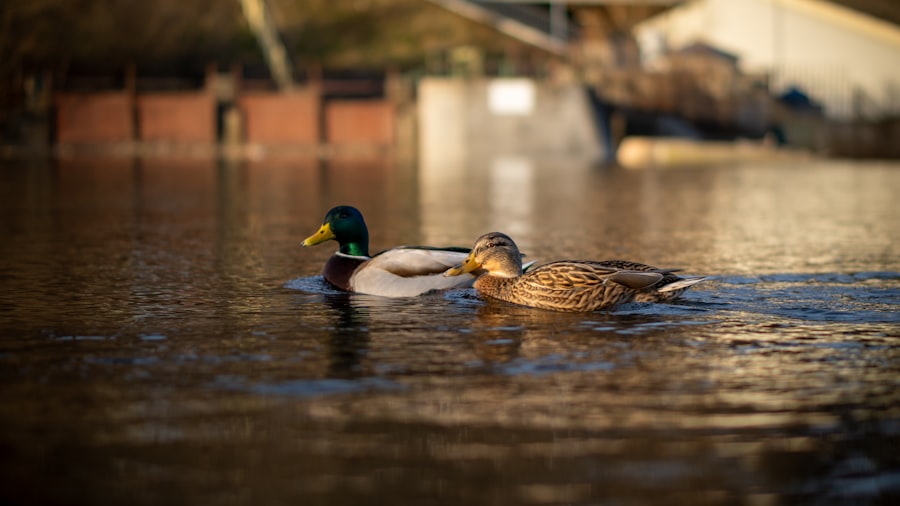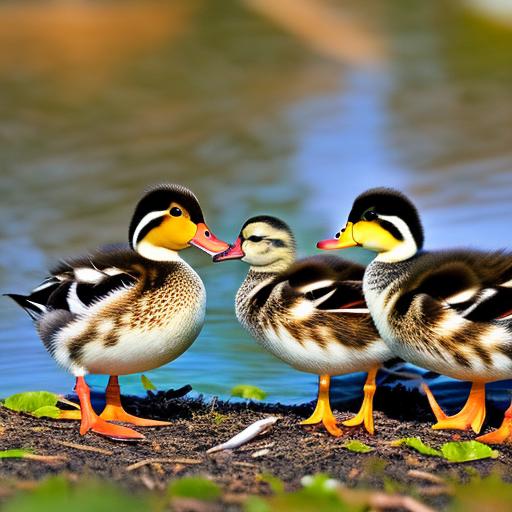Ducks are fascinating creatures that come in a variety of breeds, each with its own unique characteristics and traits. Understanding the different types of ducks is important for anyone interested in raising or keeping ducks as pets. Whether you are looking for a breed that is good for egg production, meat production, or simply as a companion animal, knowing the differences between duck breeds can help you make an informed decision.
Key Takeaways
- There are many different types of duck breeds, each with their own unique characteristics and traits.
- Some of the most popular duck breeds include the Pekin, Muscovy, and Mallard.
- When raising ducklings, it’s important to provide them with proper care and nutrition to ensure their healthy development.
- From hatching to adulthood, the life cycle of a duckling is full of interesting and unique stages.
- When choosing a duck breed, it’s important to consider factors such as temperament, egg-laying ability, and climate suitability.
Popular Duck Breeds: A Guide to the Most Common Ducks
There are several popular duck breeds that are commonly found around the world. One of the most well-known breeds is the Pekin duck, which is known for its large size and white feathers. Pekin ducks are often raised for meat production and are known for their tender and flavorful meat.
Another popular breed is the Mallard duck, which is native to North America and Europe. Mallards are known for their beautiful green heads and brown bodies. They are often kept as pets or for ornamental purposes.
The Muscovy duck is another popular breed that is native to South America but can now be found worldwide. Muscovy ducks are known for their distinctive red faces and large size. They are often raised for meat production and are known for their lean and flavorful meat.
Raising Ducklings: Tips for Successful Duckling Care
Raising ducklings can be a rewarding experience, but it requires careful preparation and attention to detail. Before bringing home your ducklings, it is important to have a brooder set up and ready to go. A brooder is a warm and safe space where the ducklings can live until they are old enough to be moved outside.
The brooder should be equipped with a heat lamp or heating pad to keep the ducklings warm, as they cannot regulate their body temperature well in the early days of life. The brooder should also have a source of clean water and a non-slip surface for the ducklings to walk on.
Feeding and watering ducklings is another important aspect of their care. Ducklings should be fed a diet that is specifically formulated for their nutritional needs. This typically includes a starter feed that is high in protein. Fresh water should be available at all times, and it is important to clean and refill the water container regularly to prevent contamination.
The Life Cycle of a Duckling: From Hatching to Adulthood
The life cycle of a duckling begins when it hatches from its egg. Ducklings are precocial, which means they are able to walk, swim, and feed themselves shortly after hatching. In the first few weeks of life, ducklings grow rapidly and develop their adult feathers.
As ducklings grow, they go through several stages of development. At around 2-3 weeks old, they begin to develop their adult feathers and lose their downy fluff. By 6-8 weeks old, they are fully feathered and resemble miniature versions of their adult selves.
By the time ducklings reach 8-12 weeks old, they are considered juveniles and are ready to be moved outside to a larger enclosure or pond. At around 6 months old, ducks reach sexual maturity and are able to reproduce.
Choosing the Right Duck Breed for Your Needs: Factors to Consider
When choosing a duck breed, there are several factors to consider. One important factor is the climate and environment in which you live. Some duck breeds are better suited to cold climates, while others thrive in warmer climates. It is important to choose a breed that can tolerate the temperatures and weather conditions in your area.
Another factor to consider is the purpose of raising ducks. If you are primarily interested in egg production, breeds such as the Khaki Campbell or Indian Runner may be a good choice. If you are interested in meat production, breeds such as the Pekin or Muscovy may be more suitable.
Personal preferences should also be taken into account when choosing a duck breed. Some people may prefer the appearance or temperament of certain breeds over others. It is important to choose a breed that you find visually appealing and that fits well with your lifestyle and preferences.
Interesting Facts About Ducklings: What You Didn’t Know

Ducklings are not only adorable, but they also have some interesting behaviors and habits. For example, ducklings are known for their ability to swim shortly after hatching. Their downy feathers are naturally waterproof, allowing them to float and swim without getting wet.
Ducklings also have a unique way of communicating with each other. They use a variety of vocalizations, such as peeping and quacking, to communicate their needs and emotions. They also use body language, such as head bobbing and tail wagging, to communicate with each other and with their parents.
Another interesting fact about ducklings is that they imprint on the first moving object they see after hatching. This is usually their mother, but it can also be a human or even an inanimate object. Imprinting helps ducklings form a bond with their caregiver and learn important social behaviors.
Breeding Ducks: How to Successfully Breed Your Ducks
Breeding ducks can be a rewarding experience, but it requires careful planning and preparation. Before breeding ducks, it is important to ensure that you have a suitable breeding pair. The male duck, known as a drake, should be healthy and mature enough to breed. The female duck, known as a hen, should also be healthy and in good condition.
To encourage breeding, it is important to provide a suitable nesting area for the ducks. This can be a simple nest box or a natural area with vegetation and water. The nesting area should be secluded and protected from predators.
Once the ducks have mated, the female will lay a clutch of eggs. The eggs should be collected and placed in an incubator or under a broody hen for hatching. The incubation period for duck eggs is typically around 28 days.
Duckling Health: Common Health Issues and How to Prevent Them
Like any animal, ducklings can be prone to certain health issues. One common health issue in ducklings is respiratory infections, which can be caused by bacteria or viruses. Symptoms of respiratory infections include sneezing, coughing, and difficulty breathing. To prevent respiratory infections, it is important to provide a clean and well-ventilated environment for the ducklings.
Another common health issue in ducklings is diarrhea, which can be caused by a variety of factors including poor diet, stress, or bacterial infections. Diarrhea can lead to dehydration and other complications if not treated promptly. To prevent diarrhea, it is important to provide a balanced diet and clean water for the ducklings.
Parasites such as mites and lice can also affect ducklings. These parasites can cause itching, irritation, and feather loss. Regular cleaning and disinfection of the duckling’s environment can help prevent parasite infestations.
Duckling Nutrition: What to Feed Your Baby Ducks for Optimal Growth
Proper nutrition is essential for the healthy growth and development of ducklings. In the first few weeks of life, ducklings should be fed a starter feed that is specifically formulated for their nutritional needs. Starter feeds are high in protein and contain essential vitamins and minerals.
As ducklings grow, their nutritional needs change. At around 3-4 weeks old, they can begin to transition to a grower feed that is lower in protein but still provides the necessary nutrients for growth. By 6-8 weeks old, they can be switched to a maintenance feed that is suitable for adult ducks.
In addition to commercial feeds, ducklings can also be fed a variety of fresh foods such as fruits, vegetables, and insects. It is important to introduce new foods gradually and monitor the ducklings for any signs of digestive upset.
Caring for Ducks: Essential Tips for Keeping Your Ducks Happy and Healthy
Caring for ducks involves providing them with a suitable living environment, regular exercise and socialization, and proper grooming and hygiene. Ducks should be provided with a spacious and secure enclosure that protects them from predators and provides access to water for swimming.
Exercise is important for ducks to maintain their physical health and mental well-being. Ducks should have access to a large outdoor area where they can walk, swim, and forage for food. Regular socialization with other ducks or humans is also important to prevent boredom and promote healthy behaviors.
Grooming and hygiene are also important aspects of duck care. Ducks should have access to clean water for swimming and bathing. Their feathers should be regularly checked for parasites or signs of illness. Regular nail trims may also be necessary to prevent overgrowth.
In conclusion, understanding the different types of duck breeds is important for anyone interested in raising or keeping ducks as pets. Popular duck breeds include the Pekin, Mallard, and Muscovy. Raising ducklings requires careful preparation and attention to detail, including setting up a brooder and providing proper nutrition. The life cycle of a duckling includes several stages of development, from hatching to adulthood. When choosing a duck breed, factors such as climate, purpose, and personal preferences should be considered. Ducklings have some interesting behaviors and habits, such as their ability to swim shortly after hatching and their unique way of communicating with each other. Breeding ducks requires careful planning and preparation, including providing a suitable nesting area. Common health issues in ducklings include respiratory infections, diarrhea, and parasite infestations. Proper nutrition is essential for the healthy growth and development of ducklings, and a balanced diet should be provided at each stage of their life. Caring for ducks involves providing a suitable living environment, regular exercise and socialization, and proper grooming and hygiene. By following these tips, you can ensure that your ducks are happy and healthy.
If you’re interested in learning more about duck breeds and raising ducklings, you might also find this article on how long it takes for chicken eggs to hatch naturally quite informative. Understanding the incubation process can give you valuable insights into the development of ducklings as well. Check it out here. Additionally, if you’re considering expanding your poultry knowledge, this article on how to care for goslings could be a great resource. Goslings have similar needs to ducklings, so the information provided can be easily applied to both. Find it here. Lastly, if you’re curious about quail breeding, you may want to explore whether quails sit on their eggs like ducks do. Discover the answer and more in this article here. Happy reading!
FAQs
What are the different breeds of ducks?
There are over 100 different breeds of ducks, including the popular Pekin, Muscovy, Mallard, and Rouen.
How do you identify the gender of a duckling?
It can be difficult to identify the gender of a duckling, but some breeds have slight differences in appearance. For example, male Mallard ducklings have a darker head and a yellowish-brown body, while females have a lighter head and a brownish body.
What do ducklings eat?
Ducklings typically eat a diet of starter feed, which is high in protein and nutrients. They may also eat insects, worms, and other small creatures they find in their environment.
How long does it take for ducklings to hatch?
The incubation period for duck eggs is typically around 28 days, although this can vary slightly depending on the breed of duck.
What is the lifespan of a duck?
The lifespan of a duck can vary depending on the breed and living conditions, but most ducks live for around 5-10 years.
Can you keep ducks as pets?
Yes, ducks can make great pets! However, it’s important to do your research and make sure you have the space and resources to properly care for them. Ducks require a lot of space to roam and access to water for swimming and bathing.
Meet Walter, the feathered-friend fanatic of Florida! Nestled in the sunshine state, Walter struts through life with his feathered companions, clucking his way to happiness. With a coop that’s fancier than a five-star hotel, he’s the Don Juan of the chicken world. When he’s not teaching his hens to do the cha-cha, you’ll find him in a heated debate with his prized rooster, Sir Clucks-a-Lot. Walter’s poultry passion is no yolk; he’s the sunny-side-up guy you never knew you needed in your flock of friends!







